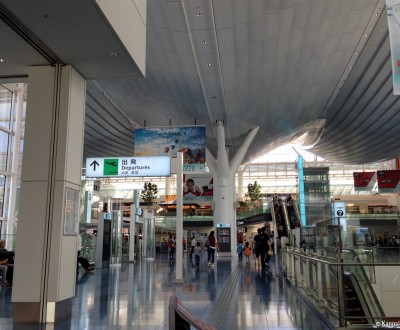Haneda Airport
More convenient than its alter ego Narita
Haneda Airport is located in Ota Ward, south of central Tokyo. Inaugurated in 1931 on the bay, the airport handles most domestic and international flights chartered by the national companies, JAL and ANA. Its main asset remains its closeness to quickly reach the city center, allowing travelers to quickly travel to and from the airport.
For many travelers to Japan, Haneda ranks as second choice after Narita for landing in Tokyo. This is explained by a simple reason: The airport cannot dislodge the image that it handles the capital's domestic air traffic and transit passengers coming to / from Asia. However, we can chase away these misconceptions because Haneda is:
- not only a historical Tokyo airport that opened in 1931 (Narita opened in 1978),
- but also (and by far) Japan's busiest one, as well as Asia's second and the world's fifth largest airport, with about 214,000 passengers a day (almost twice more than Narita in 2011).
Even, quieter than its alter ego in regard to its international terminal, Haneda has the luxury to accelerate time spent on immigration control and baggage reclaim. However, one of the main assets of this airport is without a doubt its geographical proximity to the Japanese capital. Located on Tokyo Bay (in the south), it is barely 30 kilometers away from the megacity's major districts, about half the distance of Narita (in the east).
Therefore, reaching your accommodation in the heart of the city can take up to three times less. And this will get even faster, especially when riding Tokyo Monorail 🚝. And this will get even faster, as Japan Railways started in 2023 the construction of a new train 🚅 station in the airport for a direct connection to Tokyo Station and Shinjuku, further reducing transportation times to less than 20 minutes. This new rail connection is expected to be ready for operation by March 2032.
Moreover, according to CNN, in 2019, Haneda Airport had the most punctual service for the fourth year in a row, with more than 85% of its flights on time.
New runways and terminals
Since the 2000s, the Metropolitan Government has tried to encourage travelers to use Haneda by offering foreigners privileged access to Tokyo. In 2010, with the aim of increasing Haneda traffic for tourists, the following have been inaugurated:
- a new and fourth runway, built directly on the sea (and the fifth one may already be on its way), and
- an international terminal building (the closest to the capital) that was entirely renovated and enlarged in 2014.
Given these new developments, more and more people go through this airport for arrival or departure. Transit passengers, whose planes ✈️ may land late or take off very early can stay at the "Royal Park Hotel", which is directly nested in the international terminal. The airport also has two domestic terminals: Terminal 1 for JAL and Terminal 2 for mostly ANA. The First Cabin, a famous high-end capsule hotel 🏨, can be found in this area. In July 2023, Terminal 2’s international traffic resumed at after a 3 years long hiatus. International and domestic flights are now both being operated at Terminal 2.
In addition to the vast selection of shops and restaurants spread out on a dedicated area, the top floor flaunts a large esplanade, including an open-air terrace, from which visitors can observe the constant coming and going of planes, with a picturesque Mount Fuji 🗻 in the background. But be careful of the crowd and the kerosene-heavy atmosphere! Since 2019, it is an observation platform to watch landing planes only.
Always at the forefront, Haneda tested at the end of 2015 a robotization program via three axes:
- cleaners that will work around Haneda 24/7;
- automated luggage carriers; and
- exoskeletons fitted to the luggage workers’ bodies, to improve the staff's work conditions and productivity.
In 2018, Haneda has been ranked as the world's third best airport by Skytrax, after Singapore Changi and Seoul Incheon.
On 14 March 2020, Haneda's International Terminal was renamed "Terminal 3."
Starting the end of March 2020, a new flight route opened with a capacity of 7 million passengers per year. This decision is however under critics as planes will fly over residential areas such as Shinjuku, Shibuya, Gotenba, Takanawa and Shinagawa.
In 2023, a record number of 19.1 million international passengers have used Haneda Airport, topping 2018's previous 18.2 million figure for a total number of 78,4 million travelers each year. The number of domestic flights also increased by 16% in the same year.

